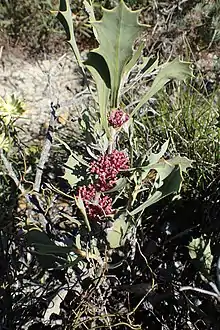| Hakea neospathulata | |
|---|---|
 | |
| Near Badgingarra | |
| Scientific classification | |
| Kingdom: | Plantae |
| Clade: | Tracheophytes |
| Clade: | Angiosperms |
| Clade: | Eudicots |
| Order: | Proteales |
| Family: | Proteaceae |
| Genus: | Hakea |
| Species: | H. neospathulata |
| Binomial name | |
| Hakea neospathulata I.M.Turner[1] | |
| Synonyms[1] | |
| |
Hakea neospathulata is a flowering plant in the family Proteaceae and is endemic to Western Australia. It is a small, dense shrub with clusters of red flowers.
Description
Hakea neospathulata is a dense shrub with spreading branches, that typically grows to a height of 1–3 m (3 ft 3 in – 9 ft 10 in) and has either smooth or hairy branchlets. The leaves are blue-grey, smooth, narrowly oval to oval shaped, arranged alternately, 2–6.5 cm (0.79–2.56 in) long and 8–16 mm (0.31–0.63 in) wide, gradually narrowing, prickly toothed margins, and tapering to a point 1.5–2 mm (0.059–0.079 in) long. The inflorescence are usually borne in clusters of 6-14 flowers in lower leaf axils, sometimes in upper axils or old wood on a smooth pedicels 3–5.5 mm (0.12–0.22 in) long, the perianth 1.5–4.5 mm (0.059–0.177 in) long and dark red or purplish. Flowering occurs from August to October and the fruit surface smooth in between sharp points ending with two short horns at the apex.[2]
Taxonomy and naming
This hakea was first described in 1870 by George Bentham who gave it the name Hakea auriculata var. spathulata in Flora Australiensis.[3][4] In 1990, Robyn Mary Barker raised the variety to species status as Hakea spathulata, noting that H. auriculata has greenish-white, cream-coloured or pink flowers near the ends of branches, whereas H. spathulata has deep red flowers usually found among older brown leaves. However, the name H. spathulata was illegitimate as it had already been validly published by Johannes Theodor Schmalhausen in 1883 as the name of a fossil hakea species found in Russia.[5][6]
In her 2006 book, Hakeas of Western Australia : a field and identification guide, Jennifer A. Young gave the distribution of H. spathulata as being limited to the area between the Murchison River and Dandaragan, and described the species as being "protected".[7]
In 2014, Ian Mark Turner raised the name Hakea neospathulata to replace the illegitimate H. spathulata.[8] The specific epithet (neospathulata) means "new-spathulate", referring to the new name for H. spathulata.[9]
Distribution and habitat
Hakea neospathulata is found at lower altitudes in sand and loam in scrubland, heath and sometimes in wet locations from the Murchison River and south to Dandaragan in the Avon Wheatbelt, Geraldton Sandplains, Jarrah Forest and Swan Coastal Plain biogeographical regions of south-western Western Australia.[7][2]
Conservation status
This hakea is classified as "not threatened" by the Government of Western Australia Department of Biodiversity, Conservation and Attractions.[2]
References
- 1 2 "Hakea neospathulata". Australian Plant Census. Retrieved 23 August 2021.
- 1 2 3 Hollister, C.; Thiele, K.R.; Lander, N.S. "Hakea neospathulata". Florabase-the Western Australia Flora. Department of Biodiversity, Conservation and Attractions. Retrieved 27 August 2021.
- ↑ "Hakea auriculata var. spathulata". APNI. Retrieved 28 August 2021.
- ↑ Bentham, George; von Mueller, Ferdinand (1870). Flora Australiensis. London: Lovell Reeve & Co. p. 510. Retrieved 28 August 2021.
- ↑ Olde, Peter M. (2017). "A preliminary checklist of fossil names in extant genera of the Proteaceae". Telopea. 20: 304. doi:10.7751/telopea10644.
- ↑ Turner, Ian Mark (2014). "Names of extant angiosperm species that are illegitimate homonyms of fossils". Annales Botanici Fennici. 51: 307. Retrieved 28 August 2021.
- 1 2 Young, Jennifer A. (2006). Hakeas of Western Australia : a field and identification guide. Perth: West Australian National Parks and Reserves Association. p. 106. ISBN 9780958577823.
- ↑ "Hakea neospathulata". APNI. Retrieved 28 August 2021.
- ↑ Sharr, Francis Aubi; George, Alex (2019). Western Australian Plant Names and Their Meanings (3rd ed.). Kardinya, WA: Four Gables Press. pp. 259–260. ISBN 9780958034180.